
Lazurite, old name Azure spar is a tectosilicate mineral with sulfate, sulfur and chloride with formula (Na,Ca)8[(S,Cl,SO4,OH)2|(Al6Si6O24)]. It is a feldspathoid and a member of the sodalite group. Lazurite crystallizes in the isometric system although well‐formed crystals are rare. It is usually massive and forms the bulk of the gemstone lapis lazuli.

Celestine (the IMA-accepted name) or celestite is a mineral consisting of strontium sulfate (SrSO4). The mineral is named for its occasional delicate blue color. Celestine and the carbonate mineral strontianite are the principal sources of the element strontium, commonly used in fireworks and in various metal alloys.
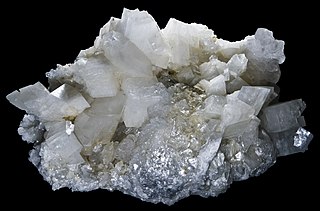
Dolomite is an anhydrous carbonate mineral composed of calcium magnesium carbonate, ideally CaMg(CO3)2. The term is also used for a sedimentary carbonate rock composed mostly of the mineral dolomite (see Dolomite (rock)). An alternative name sometimes used for the dolomitic rock type is dolostone.
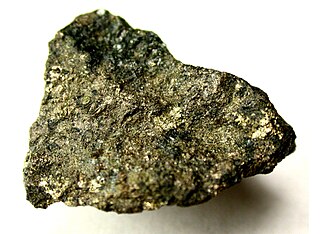
Pentlandite is an iron–nickel sulfide with the chemical formula (Fe,Ni)9S8. Pentlandite has a narrow variation range in nickel to iron ratios (Ni:Fe), but it is usually described as 1:1. In some cases, this ratio is skewed by the presence of pyrrhotite inclusions. It also contains minor cobalt, usually at low levels as a fraction of weight.

Rhodochrosite is a manganese carbonate mineral with chemical composition MnCO3. In its pure form (rare), it is typically a rose-red colour, but it can also be shades of pink to pale brown. It streaks white, and its Mohs hardness varies between 3.5 and 4.5. Its specific gravity is between 3.45 and 3.6. The crystal system of rhodochrosite is trigonal, with a structure and cleavage in the carbonate rhombohedral system. The carbonate ions (CO2−
3) are arranged in a triangular planar configuration, and the manganese ions (Mn2+) are surrounded by six oxygen ions in an octahedral arrangement. The MnO6 octahedra and CO3 triangles are linked together to form a three-dimensional structure. Crystal twinning is often present. It can be confused with the manganese silicate rhodonite, but is distinctly softer. Rhodochrosite is formed by the oxidation of manganese ore, and is found in South Africa, China, and the Americas. It is one of the national symbols of Argentina and the state of Colorado.

Weloganite is a rare carbonate mineral with the formula: Na2(Sr,Ca)3Zr(CO3)6·3H2O. It was discovered by Canadian government mineralogist Ann P. Sabina in 1967 and named for Canadian geologist Sir William Edmond Logan (1798–1875). It was first discovered in Francon Quarry, Montreal, Quebec, Canada and has only been reported from a few localities worldwide.
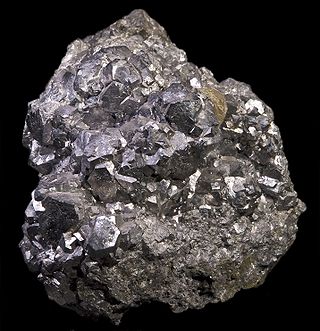
Skutterudite is a cobalt arsenide mineral containing variable amounts of nickel and iron substituting for cobalt with the ideal formula CoAs3. Some references give the arsenic a variable formula subscript of 2–3. High nickel varieties are referred to as nickel-skutterudite, previously chloanthite. It is a hydrothermal ore mineral found in moderate to high temperature veins with other Ni-Co minerals. Associated minerals are arsenopyrite, native silver, erythrite, annabergite, nickeline, cobaltite, silver sulfosalts, native bismuth, calcite, siderite, barite and quartz. It is mined as an ore of cobalt and nickel with a by-product of arsenic.

Erythrite, also known as red cobalt, previously cobalt ochre is a secondary hydrated cobalt arsenate mineral with the formula Co
3(AsO
4)
2•8H
2O. Erythrite and annabergite, chemical formula Ni
3(AsO
4)
2•8H
2O, or nickel arsenate form a complete series with the general formula (Co,Ni)
3(AsO
4)
2•8H
2O.

Vaterite is a mineral, a polymorph of calcium carbonate (CaCO3). It was named after the German mineralogist Heinrich Vater. It is also known as mu-calcium carbonate (μ-CaCO3). Vaterite belongs to the hexagonal crystal system, whereas calcite is trigonal and aragonite is orthorhombic.

Adamite is a zinc arsenate hydroxide mineral, Zn2AsO4OH. It is a mineral that typically occurs in the oxidized or weathered zone above zinc ore occurrences. Pure adamite is colorless, but usually it possess yellow color due to Fe compounds admixture. Tints of green also occur and are connected with copper substitutions in the mineral structure. Olivenite is a copper arsenate that is isostructural with adamite and there is considerable substitution between zinc and copper resulting in an intermediate called cuproadamite. Zincolivenite is a recently discovered mineral being an intermediate mineral with formula CuZn(AsO4)(OH). Manganese, cobalt, and nickel also substitute in the structure. An analogous zinc phosphate, tarbuttite, is known.

Annabergite is an arsenate mineral consisting of a hydrous nickel arsenate. It is considered a member of the vivianite group and known for its ability to form crystals in a characteristic apple-green color.
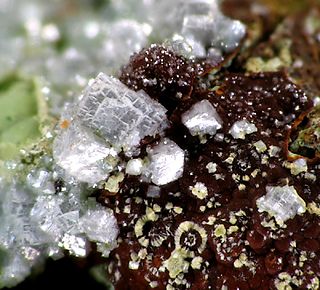
Otavite is a rare cadmium carbonate mineral with the formula CdCO3. Otavite crystallizes in the trigonal system and forms encrustations and small scalenohedral crystals that have a pearly to adamantine luster. The color is white to reddish to yellow brown. Its Mohs hardness is 3.5 to 4 and the specific gravity is 5.04. Associated minerals include azurite, calcite, malachite, and smithsonite.
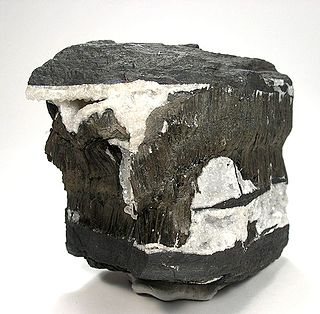
Todorokite is a complex hydrous manganese oxide mineral with generic chemical formula (Na,Ca,K,Ba,Sr)
1-x(Mn,Mg,Al)
6O
12·3-4H
2O. It was named in 1934 for the type locality, the Todoroki mine, Hokkaido, Japan. It belongs to the prismatic class 2/m of the monoclinic crystal system, but the angle β between the a and c axes is close to 90°, making it seem orthorhombic. It is a brown to black mineral which occurs in massive or tuberose forms. It is quite soft with a Mohs hardness of 1.5, and a specific gravity of 3.49 – 3.82. It is a component of deep ocean basin manganese nodules.

Nyerereite is a very rare sodium calcium carbonate mineral with formula Na2Ca(CO3)2. It forms colorless, platey pseudohexagonal orthorhombic crystals that are typically twinned. It has a specific gravity of 2.54 and indices of refraction of nα=1.511, nβ=1.533 and nγ=1.535. Nyerereite is not stable in contact with the atmosphere and rapidly breaks down. Collection specimens must be kept in a sealed argon environment.
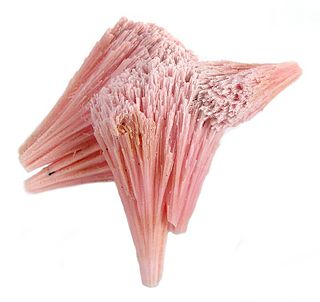
Kutnohorite is a rare calcium manganese carbonate mineral with magnesium and iron that is a member of the dolomite group. It forms a series with dolomite, and with ankerite. The end member formula is CaMn2+(CO3)2, but Mg2+ and Fe2+ commonly substitute for Mn2+, with the manganese content varying from 38% to 84%, so the formula Ca(Mn2+,Mg,Fe2+)(CO3)2 better represents the species. It was named by Professor Bukowsky in 1901 after the type locality of Kutná Hora, Bohemia, in the Czech Republic. It was originally spelt "kutnahorite" but "kutnohorite" is the current IMA-approved spelling.

Howlite, a calcium borosilicate hydroxide (Ca2B5SiO9(OH)5), is a borate mineral found in evaporite deposits.

Athabascaite is a member of the copper selenide minerals, and forms with other copper selenides. It was first discovered by S. Kaiman in 1949 while he was researching radioactive materials around Lake Athabasca. Kaiman was conducting research near Uranium City, Saskatchewan where mass amounts of uranium mines were present.
Clearcreekite is a carbonate mineral, polymorphous with peterbaylissite. The chemical formula of clearcreekite is Hg(1+)3CO3(OH)∙2H2O. It has a pale greenish yellow color and streak with tabular subhedral crystals and good cleavage on {001}. It is transparent with vitreous luster and uneven fracture. Its density (calculated from the idealized formula) is 6.96 g/cm3. The mineral is monoclinic with the space group P2/c. Clearcreekite is an extremely rare mineral from the Clear Creek mercury mine, New Idria district, San Benito County, California. It was probably formed after the alteration of other mercury minerals such as cinnabar. The mineral is named after the locality where it was found.

Lavendulan is an uncommon arsenate mineral in the lavendulan group. It is known for its characteristic intense electric blue colour. Lavendulan is very similar to Lemanskiite, the analogue trihydrate mineral, to the point of them being considered dimorphs. Lemanskiite is tetragonal, but lavendulan is monoclinic. Lavendulan has the same structure as sampleite, and the two minerals form a series. It is the calcium analogue of zdenĕkite and the arsenate analogue of sampleite.
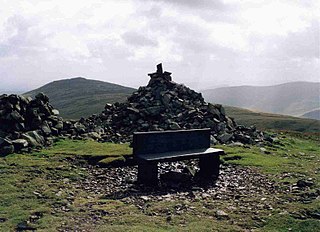
Ianbruceite is a rare hydrated zinc arsenate with the formula [Zn2(OH)(H2O)(AsO4)](H2O)2; material from the Driggith mine has traces of cobalt. It was first discovered at Tsumeb, approved by the International Mineralogical Association as a new mineral species in 2011, reference IMA2011-49, and named for Ian Bruce, who founded "Crystal Classics" in the early 1990s, and was heavily involved in attempts to reopen the famous Tsumeb mine for specimen mining.
In 2013 new occurrences of ianbruceite were reported from the neighbouring Driggith and Potts Gill mines on High Pike in the Caldbeck Fells, Cumbria, England. Here the mineral is probably a post-mining product. Caldbeck Fells and Tsumeb are the only reported localities for ianbruceite to date (May 2013).




















